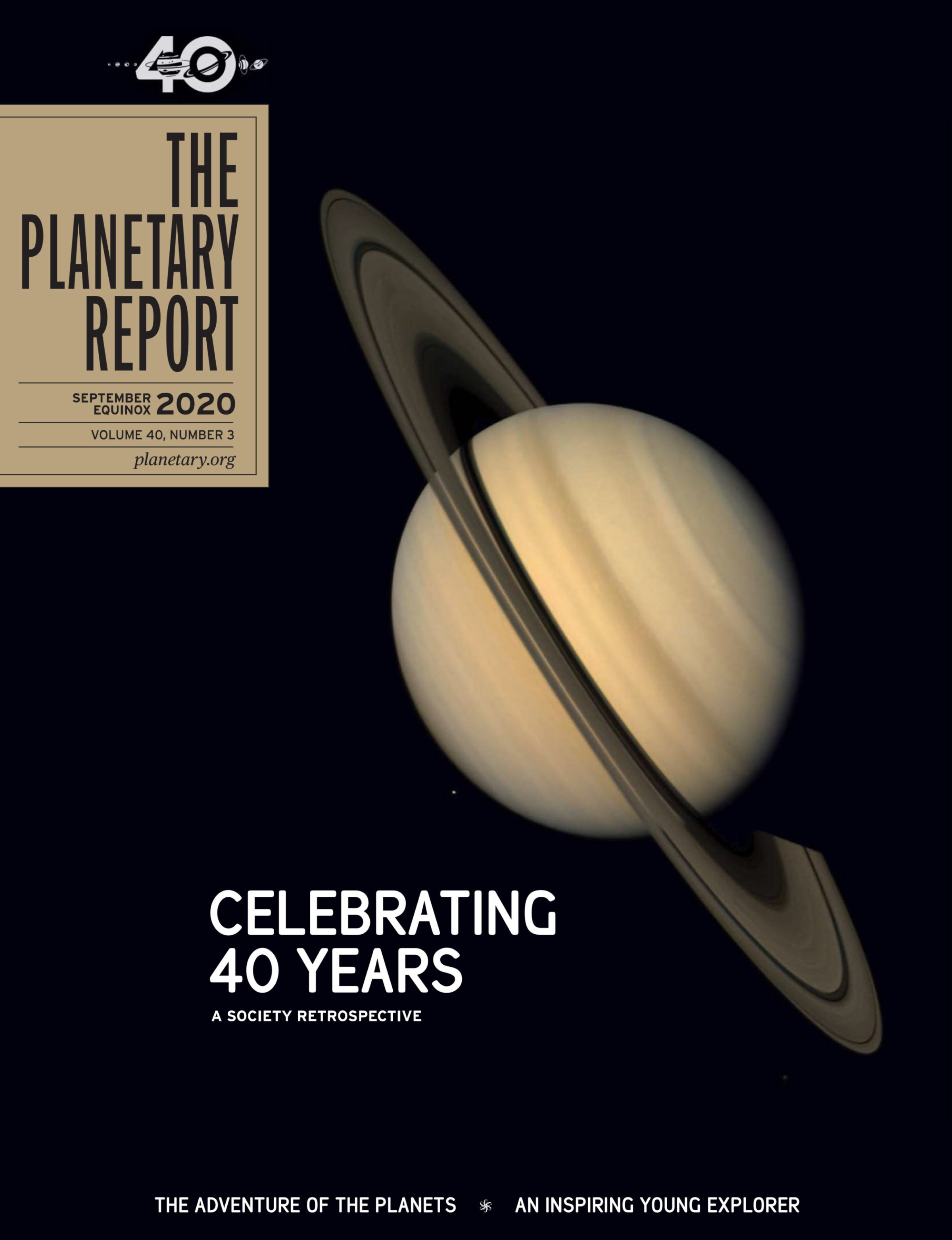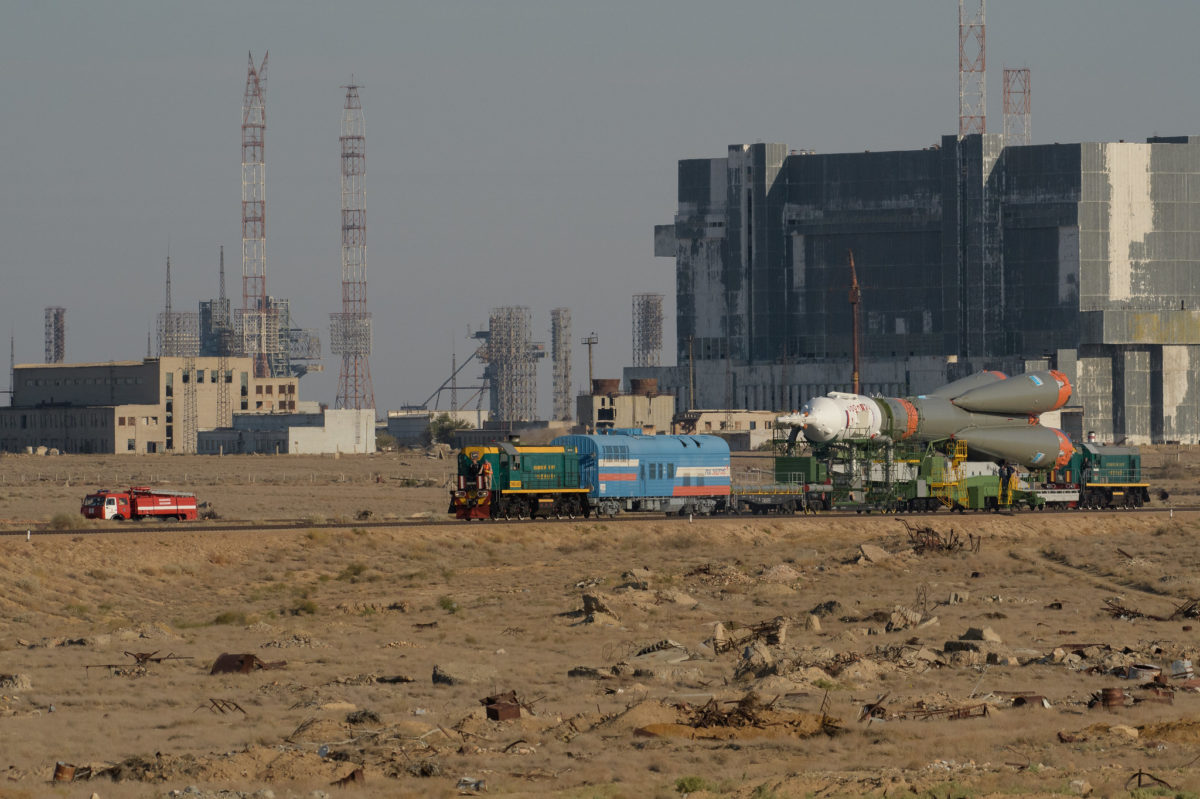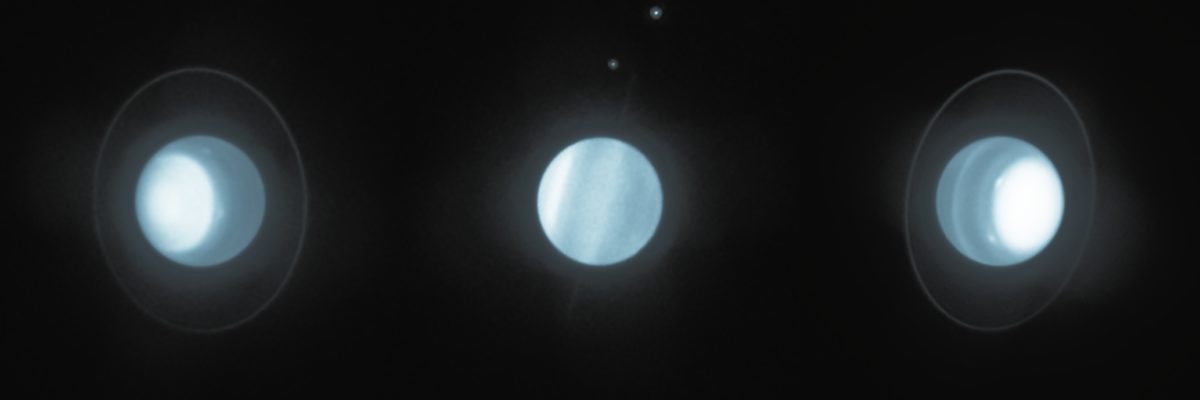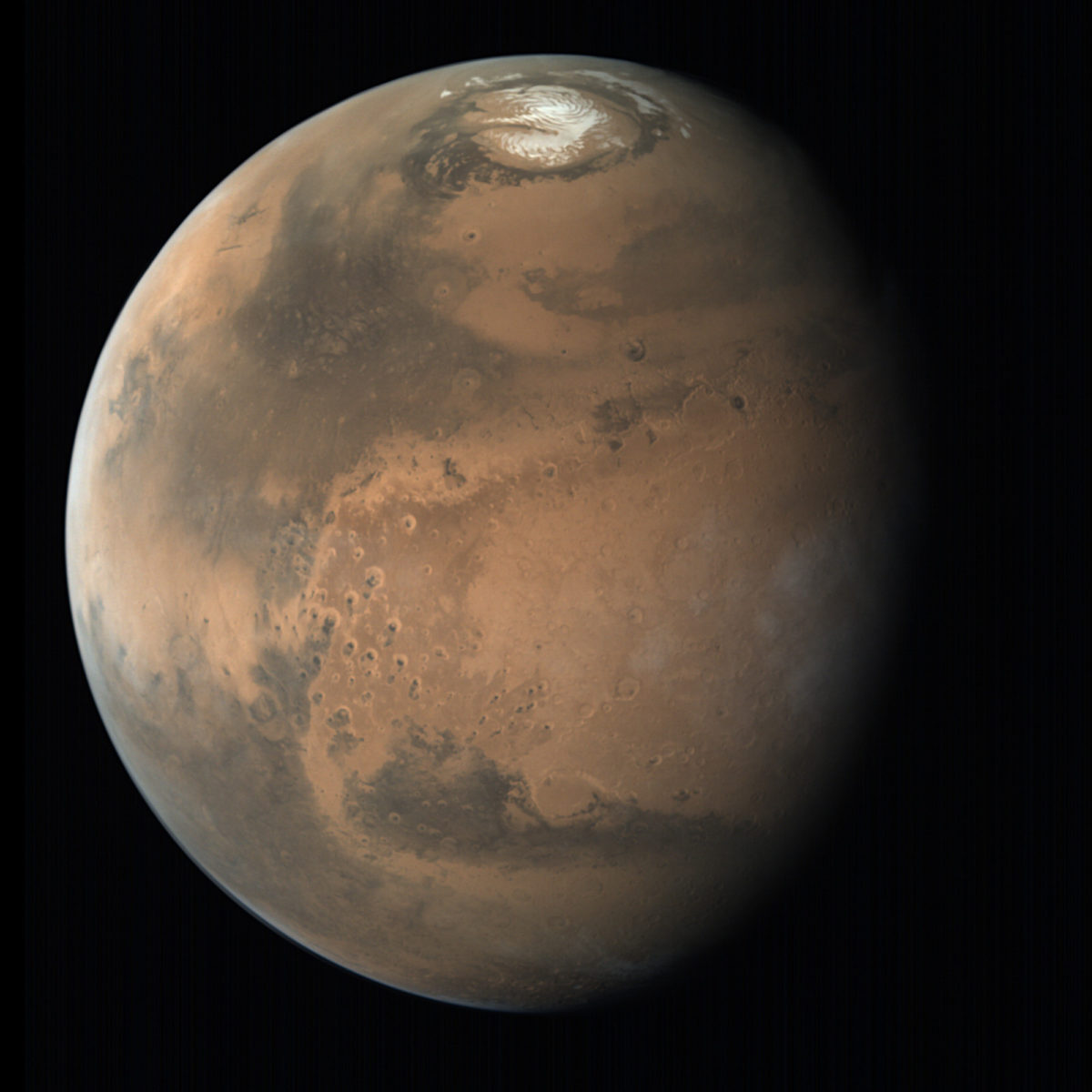
On the Cover: The first issue of The Planetary Report was published in December 1980. For that cover image, our cofounders chose the last picture from Voyager 1’s approach to Saturn in which the entire planet and ring system can be seen in a single frame. For our 40th anniversary issue, Björn Jónsson reprocessed the same Voyager data using modern techniques, revealing stunning new details. Credit: NASA/JPL/Björn Jónsson
Download PDF
A Planetary Society Retrospective
Look back at the remarkable achievements our members have made over the past 4 decades, alongside other space milestones and events.
Your Impact: September Equinox 2020
We’ve made some big changes to planetary.org, as we continue to advance advocacy, defend Earth, and chart the future of space exploration.
Space on Earth
Tried-and-True Workhorse: Russian Rocket Continues to Deliver

Most of today's rockets look a lot different from the ones in use when The Planetary Society was founded in 1980. One notable exception is the venerable Russian Soyuz, which has been operating since 1967. Although the launcher has received various upgrades over time, there is little to visually distinguish a modern Soyuz from its predecessors. Here, a train hauls the Soyuz rocket that launched Russia’s Oleg Skripochka, NASA’s Jessica Meir, and the United Arab Emirates’ Hazzaa Ali Almansoori to the International Space Station on 25 September 2019. The launch pad, located in Baikonur, Kazakhstan, sits on the same spot where Yuri Gagarin blasted off in 1961 to become the first human in space, and Sputnik 1—Earth’s first artificial satellite—was launched. Cold War-era structures loom large over the scene along with rusting rubble near the train tracks.
Snapshots From Space
Uranus' Seasons Revealed

Forty years is a lot of time here on Earth, but on Uranus, not so much. The ice giant takes 84 Earth years to orbit the Sun, so over the entire course of The Planetary Society’s existence, not even half a Uranian year has passed. Uranus is famously tipped on its side relative to the other planets, but just like Earth, it has seasons, as shown in these 3 images taken by the Hubble Space Telescope in 1995, 2007, and 2019.
In the left image from 1995, Uranus’ south pole is at center-left, and the north pole is hidden. The 2007 image was taken during equinox, when the planet’s rings sat edge-on to Earth, appearing nearly invisible. In the 2019 image at right, the north pole is in view, while the south pole is hidden.
Annual images of the outer planets by Hubble help scientists understand planetary atmospheres. These pictures were processed, colorized, and oriented to look consistent by Judy Schmidt, an amateur astronomer who specializes in archival Hubble image processing.
Your Place in Space
Our Past Informs Our Future: Looking Back at Carl Sagan’s Founding Essay From December 1980
By Bill Nye, Planetary Society CEO
You and I have come a long way since Carl Sagan wrote his compelling essay “The Adventure of the Planets” back in the 20th century (see The Planetary Report vol. 1 no. 1, 1980).
Just as he suggested, the very existence of The Planetary Society, today the world’s largest independent space organization, demonstrates that citizens of Earth consider the exploration of planets and other worlds to be a wonderful and worthy use of our human abilities.
Professor Sagan pointed out that we would one day know a great deal more about the cosmos than we did back when he crafted those words 40 years ago—as long as we stayed the course.
He and his cofounders Bruce Murray and Louis Friedman created this organization to petition governments and space agencies, advocating for missions to the planets in our solar system and for instruments to explore objects way out there beyond our Sun.
Thanks to you, we’ve stayed the course.
It’s because of the extraordinary feats of exploration that our species has performed during our brief time on Earth that you and I know that we live on a planet with a moon, that the brighter dots in the night sky are other planets, and that every twinkling star is probably the center of its own solar system with its own diverse and intriguing worlds and moons.
Space is hard; exploring it takes time, and it is vital. When scientists decide to take on a project like returning samples from the surface of Mars, it takes decades to accomplish the project. It requires decades of funding, and year after year, as governments set their nation’s budgets through economic ups and downs, legislators are often tempted to cut costs and cancel programs that may not seem to have immediate payoffs or obvious benefits for their constituents. Meanwhile, these distant worlds cry out for exploration and discovery and speak to us about our own planet. The more we learn about planetary worlds of all kinds, the more we will understand our Earth and how we can ensure a better future for species everywhere, especially our own.
It is as important as ever to speak up as a space advocate. The Planetary Society and our members around the world are here to educate legislators about the value of exploration. We are here to make it known that people—voters, taxpayers, kids (the explorers of tomorrow)— want their governments to keep funding space. We are here to grow a global community of supporters who want ambitious exploration that leads to amazing discoveries and understanding.
I’m proud to see the progress that has been made in space science and exploration since Carl Sagan penned “The Adventure of the Planets.” I hope we all look up and wonder where we’ll be 40 years from now—exploring worlds beyond the sky and learning more about the cosmos and our place within it.
Get Involved
From Bits to Beautiful

Whenever a spacecraft captures an image of a planet, moon, asteroid, or any other celestial object, it sends that photo back to Earth as raw data. What you may not know is that this raw data is freely accessible to the public. In a new, free online course, Solar System Specialist Emily Lakdawalla shows you how to access this data and process it into stunning images. Not only do you get the satisfaction of discovering what a spacecraft is seeing but you can also make valuable contributions to space exploration by generating unique space images like the ones featured throughout this magazine (many of which were produced by amateur image processors). Learn how to make your own space images at courses.planetary.org and show off what you make by sending it to us at [email protected].
Discover the Cosmos Right at Home
Whether you have access to a backyard or just your window and are using a telescope or just your eyes, there’s a lot to see when you look up at the night sky. Planetary Society members sent us their top tips for enjoying stargazing and planet watching, which we’ve compiled into an easy beginner’s guide. Once you start exploring the night sky, there’s no limit to what you’ll find. Check out the guide at planet.ly/beginnersastronomy.
Be a Planetary Defender
By the time this magazine reaches you, The Planetary Society will be wrapping up our campaign to raise funds for planetary defense. If you haven’t had a chance to make your gift yet, it’s not too late to help. Your support will help us pursue a variety of activities to protect Earth from asteroid impacts by finding, tracking, characterizing, and deflecting incoming asteroids and coordinating all these efforts internationally. Learn more and support planetary defense at planet.ly/defendearth.
Take Action With Us
One of the awesome features of our new website is a one-stop-shop action center where you can find ways to make your mark on the future of space exploration. Whether it is teaching someone about the critical importance of planetary defense, signing a petition for NASA funding, or speaking up about timely policy issues, you can make a difference right now by going to planetary.org/action-center.
Calling All Creatives!

Do you create art or maybe music, poetry, sculpture, or fashion to celebrate your love of space? Whatever your creative outlet, we want to hear from you! We’re inviting members from around the world to send us your artwork so that we can showcase the amazing variety of creations that space inspires. You can share your creativity with us by emailing [email protected].
Old School Space Style
Forty years after our founding date, we still love the style of The Planetary Society’s original logo. You can get in on this blast from the past with our awesome retro T-shirt. Every purchase supports our mission to advance space science and exploration. Purchase yours today at planetary.org/store.
What's Up?
In the Sky

By Bruce Betts, Planetary Society Chief Scientist
There is great sky stuff this quarter! Around the time of its 6 October closest approach, Mars will be 3 times brighter than the brightest star and brighter than Jupiter. Mars’ brightness varies considerably as Earth and Mars orbit, and now is a very bright period. Mars won’t be any closer until 2035. Very bright Jupiter and yellowish Saturn are in the evening West. On 21 December, they will be extremely close together in the sky. An almost-new Moon will provide dark skies for the Geminids meteor shower, peaking on 13/14 December. The Geminids are usually the best shower of the year with 100+ meteors per hour from a dark site. A total solar eclipse will be visible from portions of Chile and Argentina on 14 December with a partial eclipse visible from much of South America (see planetary.org/eclipse). Super-bright Venus dominates the predawn East.
Random Space Fact
On 21 December 2020, Jupiter and Saturn will be closer in the sky than they have appeared in almost 400 years. They will be 7 arc minutes apart or less than 1/4 the width of a full Moon.
Trivia Contest
Our March equinox contest winner is Jano Mladonicky of The Woodlands, Texas, USA. Congratulations! The question was: Approximately how many of Earth’s Moon would fit inside Earth (assuming no void space, i.e., assuming the volume of Moons smooshes into the volume of Earth)? The answer: Approximately 49 Moons would fit inside Earth.
Try to win a copy of My First Book of Planets by Bruce Betts and a Planetary Radio T-shirt by answering this question:
In 2020, about how much farther away is the Moon from Earth (average distance) than it was when The Planetary Society was founded in 1980?
Email your answer to [email protected] or mail your answer to The Planetary Report, 60 S. Los Robles Ave., Pasadena, CA 91101. Make sure you include the answer and your name, mailing address, and email address (if you have one). By entering this contest, you are authorizing The Planetary Report to publish your name and hometown. Submissions must be received by 1 December 2020. The winner will be chosen in a random drawing from among all the correct entries received.
For a weekly dose of “What’s Up?” complete with humor, a weekly trivia contest, and a range of significant space and science-fiction guests, listen to Planetary Radio at planetary.org/radio.
Where We Are
An At-a-Glance Spacecraft Locator

Three new spacecraft are currently cruising to Mars. NASA’s Perseverance rover, China’s Tianwen-1 orbiter and rover, and the United Arab Emirates’ Hope orbiter all launched successfully in July and August and are scheduled to arrive in February 2021.
The European Space Agency’s BepiColombo spacecraft will perform its first Venus flyby on 15 October using the planet’s gravity to shape the probe’s orbit as it journeys to Mercury. Five days later on 20 October, NASA’s OSIRIS-REx spacecraft is scheduled to make its first sample collection attempt at asteroid Bennu. OSIRIS-REx will remain at Bennu until 2021 and return its samples to Earth in 2023.
Meanwhile, Japan’s Hayabusa2 spacecraft is slowly closing in on Earth, where it will drop off its precious samples from asteroid Ryugu in December. The samples, protected in an atmospheric reentry capsule, will land in Australia while Hayabusa2 cruises onward to possibly visit another asteroid during an extended mission. Also scheduled for December is the launch of China’s Chang’e-5 sample return mission to the Moon.
Why I Explore
I Am the Cosmos

I was born at 11:11 p.m. on a starry night with a full Moon, so maybe that’s why the night sky always pulls me. I have loved space from as far back as I can remember.
Being 10 years old, I haven’t been to space yet, but I am always looking up. One crisp September night, my mom and I were walking on the boardwalk when I noticed the Moon, Mars, and Jupiter shining bright over the ocean—a moment I will never forget!
I am always exploring. I love to look for tardigrades in wet moss, flip logs to discover salamanders, and hunt rock piles for fossils. So far, I have found 2 fossils! My life goal is to go to Mars to analyze the rocks there for biosignatures like stromatolites.
In the first 10 years of my life, I have witnessed phenomenal achievements by the science community. We have photographed black holes, discovered exoplanets, and launched LightSails. However, my generation has also inherited a mass extinction event due to a human-caused climate crisis. I aim to use the same ingenuity that drives space exploration to solve environmental tragedies on our home planet.
I will be 70 years old when The Planetary Society turns 100. Maybe by then we will divert dangerous asteroids, find life on Mars, or reverse climate change!
The fact that we are all made of star stuff tells me that I AM the cosmos, not just an observer. I am as connected to the vastness of space above me as I am to an ant, an oak tree, and my fellow humans all across the globe. It is my hope that together we can sail to the stars while holding dear our connection to each other here on Earth.
— Heidi Jacobs is a 10-year-old student at Haddonfield Friends School, a Quaker school in New Jersey. She is a proud member of The Planetary Society; in fact, she mows lawns to earn money to donate! When not looking through her telescope, Heidi enjoys horseback riding, swim team, and writing. She loves to travel near or far and is always up for an adventure.
Astronomical Art
Space Odyssey by Pavel Gabzdyl

In this issue of The Planetary Report, we look back over 40 years of exploration and forward to what is to come. This piece of artwork by Planetary Society member Pavel Gabzdyl, a science communicator from Brno Planetarium in the Czech Republic, gives the feeling of gazing through time and space. From a distance, we look out upon our home planet and beyond.
The overwhelming feeling is one of awe, wonder, and appreciation. As we look back over our organization’s history and forward to the future of exploration, we feel the same. Thank you to all of our members and supporters who have made this possible. We look forward to enjoying the next decades of exploration alongside you.
Do you want to see your artwork here? We love to feature our members throughout this magazine. Send your original, space-related artwork to [email protected].
The Planetary Report • September Equinox 2020
Help advance space science and exploration! Become a member of The Planetary Society and you'll receive the full PDF and print versions of The Planetary Report.


 Explore Worlds
Explore Worlds Find Life
Find Life Defend Earth
Defend Earth



